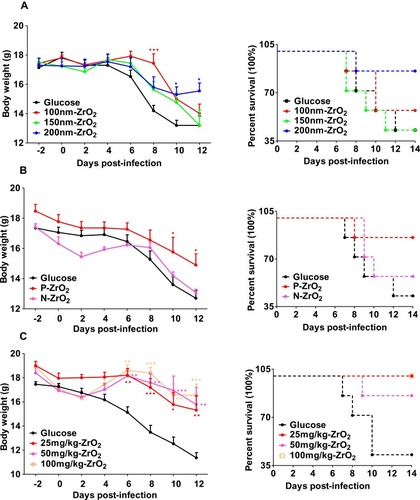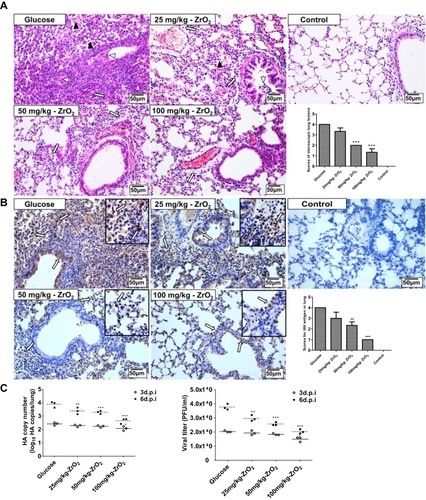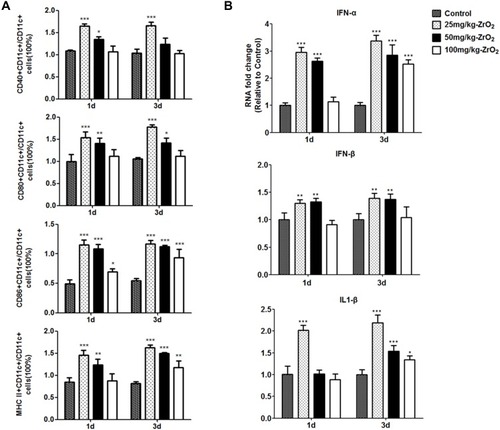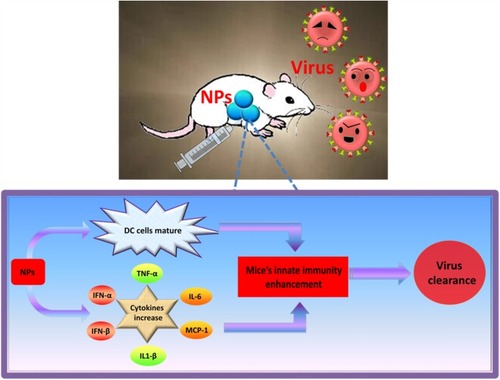Figures & data
Figure 1 Transmission electron microscopy images of various diameters of ZrO2 in 5% glucose solution. The well-defined size and shape of 100 (A), 100 (B), and 200 nm (C) ZrO2 nanoparticles (NPs) allowed for good monodispersity in 5% glucose solution. The scale bar is 100 nm.

Figure 2 Positively-charged ZrO2 at a dosage of 100 mg/kg increased survival of H5N1-infected mice. ZrO2 of different diameters (100, 150, and 200 nm) (A), with different charges (positive and negative) (B) or at different dosages (25, 50, and 100 mg/kg) (C) were administered twice intraperitoneally to mice, one day apart. On the second day of NP administration, the viral challenge was administered, with triple the LD50 of H5N1. Body weights were determined every 2 days. *, P < 0.05; **, P < 0.01; ***, P < 0.001 and compared to the glucose group.

Figure 3 Positively-charged ZrO2 NPs of 200 nm reduced lung injury and viral replication in H5N1-infected mice. (A) Representative lung sections from each group were stained with H&E (400×) and scored in a blind study. The black triangles show alveolar lumen flooded with edema fluid and mixed with exfoliated alveolar epithelial cells, inflammatory cells, and erythrocytes. Arrows represent interstitial edema and inflammatory cellular infiltration around small blood vessels and bronchioles. Empty triangles indicate reduction in the number of mucous epithelial cells in bronchioles. (B) Representative lung sections from each group were stained using IHC (400×) and scored in a blind study. Arrows indicate positive cells. (C) Expression levels of HA genes were determined via qPCR and their PFU values were determined through plaque assay. These results were obtained from three distinct animals and are representative of three independent experiments. *, P < 0.05;**, P < 0.01 and ***, P < 0.001 compared to the glucose group.

Figure 4 Positively-charged ZrO2 NPs of 200 nm could enhance the maturation of dendritic cells (DCs) and promote expression of cytokines associated with innate immunity in mice. Non-infected mice were sacrificed on days 1 and 3 after intraperitoneal administration and spleens were collected. (A) Maturation of DCs was measured through FACS analysis. (B) Expression levels of cytokines (IFN-α, IFN-β, and IL1-β) were determined through qPCR. These results are mean ± SD values obtained from three distinct animals and are representative of three independent experiments. *, P < 0.05; **, P < 0.01; and ***, P < 0.001 compared to the control group.

Figure 5 Positively-charged ZrO2 NPs of 200 nm suppressed cytokine overexpression in the lungs of H5N1-infected mice. The expression levels of cytokines (IFN-γ, IP-10, MCP-1, IL-12, IL-6, and TNF-α) in the lung were determined through qPCR (A) and ELISA (B). These results are mean ± SD values obtained from three distinct animals and are representative of three independent experiments. *, P < 0.05; **, P < 0.01; and ***, P < 0.001 compared to the glucose group.

Figure 6 Overview of findings. Positively-charged ZrO2 of 200 nm size and 100 mg/kg dose conferred protection against H5N1 infection in mice. The mechanisms are related to ZrO2-mediated enhancement of innate immunity in the early stage of H5N1 infection. The appropriate nanoparticle treatment could reduce viral load and suppress the inflammatory cytokine storm in the lungs of H5N1-infected mice, thus preventing lung injury and improving the survival rate of the infected mice.

